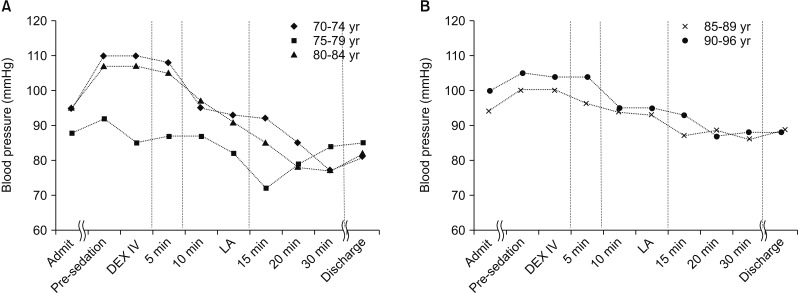J Korean Assoc Oral Maxillofac Surg.
2019 Jun;45(3):152-157. 10.5125/jkaoms.2019.45.3.152.
Sedation with dexmedetomidine in elderly patients during dental surgery: a retrospective case series
- Affiliations
-
- 1Department of Oral and Maxillofacial Surgery, Faculty of Medicine, Fukuoka University, Fukuoka, Japan. miichan@fukuoka-u.ac.jp
- KMID: 2451322
- DOI: http://doi.org/10.5125/jkaoms.2019.45.3.152
Abstract
OBJECTIVES
The number of elderly patients with systemic basal disease requiring invasive dental treatment has increased. Appropriate prediction of surgical invasiveness and combined use of psychosedation are thought to contribute to safe whole-body management. Dexmedetomidine (DEX) exhibits analgesic and anti-anxiolytic properties and causes mild respiratory depression. Studies regarding DEX use in elderly non-intubated patients are scarce. We aimed to use retrospective data to determine an effective dose of DEX to induce adequate sedation in elderly patients undergoing invasive dental surgery under local anesthesia.
MATERIALS AND METHODS
One hundred two patients aged 70 to 96 years were presumably appropriately controlled with sedation. DEX was administered at an initial loading dose of 2.0 to 3.1 µg/kg/hr for 10 minutes. We divided the patients into five groups by age and compared their blood pressures and heart rates.
RESULTS
In all five groups, blood pressure decreased suddenly at approximately 15 and 20 minutes after DEX administration. A marked decrease in blood pressure was noted in patients aged 75 to 79 years.
CONCLUSION
For elderly patients aged 75 years and above, the initial loading dose of DEX needs to be reduced to lower than half that required for young and middle-age adults.
Keyword
MeSH Terms
Figure
Reference
-
1. Cormack JR, Orme RM, Costello TG. The role of alpha2-agonists in neurosurgery. J Clin Neurosci. 2005; 12:375–378. PMID: 15925765.2. Ebert TJ, Hall JE, Barney JA, Uhrich TD, Colinco MD. The effects of increasing plasma concentrations of dexmedetomidine in humans. Anesthesiology. 2000; 93:382–394. PMID: 10910487.
Article3. Constantin JM, Momon A, Mantz J, Payen JF, De Jonghe B, Perbet S, et al. Efficacy and safety of sedation with dexmedetomidine in critical care patients: a meta-analysis of randomized controlled trials. Anaesth Crit Care Pain Med. 2016; 35:7–15. PMID: 26700947.
Article4. Cillo JE Jr, Finn R. Hemodynamics in elderly coronary artery disease patients undergoing propofol sedation. J Oral Maxillofac Surg. 2006; 64:1338–1342. PMID: 16916666.
Article5. Taguchi T, Fukuda K, Sekine H, Kakizawa T. Intravenous sedation and hemodynamic changes during dental implant surgery. Int J Oral Maxillofac Implants. 2011; 26:1303–1308. PMID: 22167437.6. Hegde S, Padmanabha S, Bhat GK. A comparison of hemodynamic responses and patient comfort in catract surgery with and without midazolam as sedation. IOSR J Dent Med Sci. 2014; 13:23–27.
Article7. Silva-Jr JM, Katayama HT, Nogueira FAM, Moura TB, Alves TL, de Oliveira BW. Comparison of dexmedetomidine and benzodiazepine for intraoperative sedation in elderly patients: a randomized clinical trial. Reg Anesth Pain Med. 2019; 44:319–324. PMID: 30777901.
Article8. Kanto JH. Midazolam: the first water-soluble benzodiazepine. Pharmacology, pharmacokinetics and efficacy in insomnia and anesthesia. Pharmacotherapy. 1985; 5:138–155. PMID: 3161005.
Article9. MacLaren R, Preslaski CR, Mueller SW, Kiser TH, Fish DN, Lavelle JC, et al. A randomized, double-blind pilot study of dexmedetomidine versus midazolam for intensive care unit sedation: patient recall of their experiences and short-term psychological outcomes. J Intensive Care Med. 2015; 30:167–175. PMID: 24227448.10. Kunisawa T, Hanada S, Kurosawa A, Suzuki A, Takahata O, Iwasaki H. Dexmedetomidine was safely used for sedation during spinal anesthesia in a very elderly patient. J Anesth. 2010; 24:938–941. PMID: 21110048.
Article11. Shah RR. Drug development and use in the elderly: search for the right dose and dosing regimen (Parts I and II). Br J Clin Pharmacol. 2004; 58:452–469. PMID: 15521892.
- Full Text Links
- Actions
-
Cited
- CITED
-
- Close
- Share
- Similar articles
-
- Dexmedetomidine intravenous sedation using a patient-controlled sedation infusion pump: a case report
- Fatal pulmonary aspiration during balanced sedation with dexmedetomidine and midazolam: A case report
- Effect of Age on Optimal Clinical Dose of Dexmedetomidine Sedation
- Role of dexmedetomidine in pediatric dental sedation
- Dexmedetomidine for Repeated Sedation in Pediatric Sedation During Consecutive Radiation Therapy



